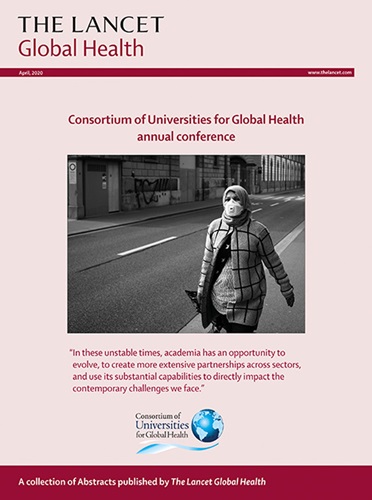马里的类鼻疽:一项回顾性观察研究。
IF 19.9
1区 医学
Q1 PUBLIC, ENVIRONMENTAL & OCCUPATIONAL HEALTH
引用次数: 0
摘要
背景:类鼻疽是一种被忽视的热带细菌感染,由革兰氏阴性土壤细菌假麦氏伯克氏菌引起,死亡率高。虽然这种疾病在亚洲和太平洋区域得到越来越多的认识,但非洲情况的特点是缺乏关于疾病负担和分布的数据和很大的不确定性。在这里,我们的目的是报告马里5岁以下儿童的类鼻疽病例,那里以前没有确诊的类鼻疽病例报告。方法:无国界医生组织在马里库蒂亚拉为5岁以下儿童开展了一个儿科方案,其中包括一个微生物实验室。2018年1月至2021年9月期间,分离细菌的生化特征表明,在有严重感染症状的入院儿童的临床样本中存在假马利氏B杆菌。对分离菌株进行全基因组测序鉴定。回顾性分析已确诊的类鼻疽病例的病程和预后的临床资料。发现31例5岁以下儿童类鼻疽确诊病例。15例(48%)为12个月或以下的婴儿。B假脓杆菌阳性样本包括28份血培养,2份胸膜液和1份脓样本。在19例可获得结果数据的患者中,12例(63%)死亡。系统发育分析显示,该菌株具有较高的遗传多样性,表明该菌株在该地区长期存在。我们估计儿科人群的年类鼻疽发病率为每10万人中8.8例(95% CI为5.7 - 11.9),而总体人群的年类鼻疽发病率为每10万人中15.5例(10.0 - 20.8)。据我们所知,这是马里报告的第一个病例系列,也是非洲报告的最大的类鼻疽病例队列。我们的年度发病率估计表明,类鼻疽病是非洲这一地区的一个重大公共卫生问题。这些发现清楚地强调需要改进诊断和观察性研究,以便更多地了解非洲类鼻疽病负担。它们还支持将类鼻疽病纳入国家卫生战略,为监测和经验性治疗方案提供信息。由于类鼻疽病对常见的经经验抗生素方案具有耐药性,因此这些措施对于降低高死亡率至关重要。本文章由计算机程序翻译,如有差异,请以英文原文为准。
Melioidosis in Mali: a retrospective observational study.
BACKGROUND
Melioidosis is a neglected tropical bacterial infection with a high mortality rate caused by the Gram-negative soil bacterium Burkholderia pseudomallei. Although the disease is increasingly recognised in Asian and Pacific regions, the situation in Africa is characterised by a scarcity of data and great uncertainty regarding the disease burden and distribution. Here, we aimed to report cases of melioidosis in children younger than 5 years in Mali, where no confirmed melioidosis had been reported previously.
METHODS
Médecins Sans Frontières maintains a paediatrics programme in Koutiala, Mali, for children younger than 5 years, including a microbiology laboratory. Between January 2018, and September 2021, biochemical characteristics of bacterial isolates suggested the presence of B pseudomallei in clinical samples from children admitted with severe signs of infection. Isolated strains were characterised by whole genome sequencing. Clinical data on the course and outcome of confirmed melioidosis cases were retrospectively analysed from the hospital records.
FINDINGS
31 melioidosis cases of children younger than 5 years were confirmed. 15 (48%) cases were in infants aged 12 months or younger. B pseudomallei-positive samples included 28 blood cultures, two pleural fluids, and one pus sample. Of 19 patients with available outcome data, 12 (63%) died. Phylogenetic analysis of the B pseudomallei isolates revealed high genetic diversity suggesting long-standing persistence of the bacterium in this region. We estimated an annual melioidosis incidence of 8·8 per 100 000 (95% CI 5·7-11·9) in the paediatric population and the derived 15·5 per 100 000 (10·0-20·8) for the overall population.
INTERPRETATION
This is, to the best of our knowledge, the first case series reported in Mali and the largest cohort of melioidosis cases ever reported in Africa. Our annual incidence estimates suggest that melioidosis is a significant public health problem in this part of Africa. These findings clearly highlight the need for improved diagnostics and observational studies to learn more about the African melioidosis burden. They also support the inclusion of melioidosis in national health strategies to inform surveillance and empiric treatment protocols. As melioidosis is resistant to common empirical antibiotic regimens, these measures are essential to reduce the high mortality rate.
FUNDING
None.
TRANSLATION
For the French translation of the abstract see Supplementary Materials section.
求助全文
通过发布文献求助,成功后即可免费获取论文全文。
去求助
来源期刊

Lancet Global Health
PUBLIC, ENVIRONMENTAL & OCCUPATIONAL HEALTH-
CiteScore
44.10
自引率
1.20%
发文量
763
审稿时长
10 weeks
期刊介绍:
The Lancet Global Health is an online publication that releases monthly open access (subscription-free) issues.Each issue includes original research, commentary, and correspondence.In addition to this, the publication also provides regular blog posts.
The main focus of The Lancet Global Health is on disadvantaged populations, which can include both entire economic regions and marginalized groups within prosperous nations.The publication prefers to cover topics related to reproductive, maternal, neonatal, child, and adolescent health; infectious diseases (including neglected tropical diseases); non-communicable diseases; mental health; the global health workforce; health systems; surgery; and health policy.
 求助内容:
求助内容: 应助结果提醒方式:
应助结果提醒方式:


